 源码剖析-插件机制
源码剖析-插件机制
# 12.1 插件概述
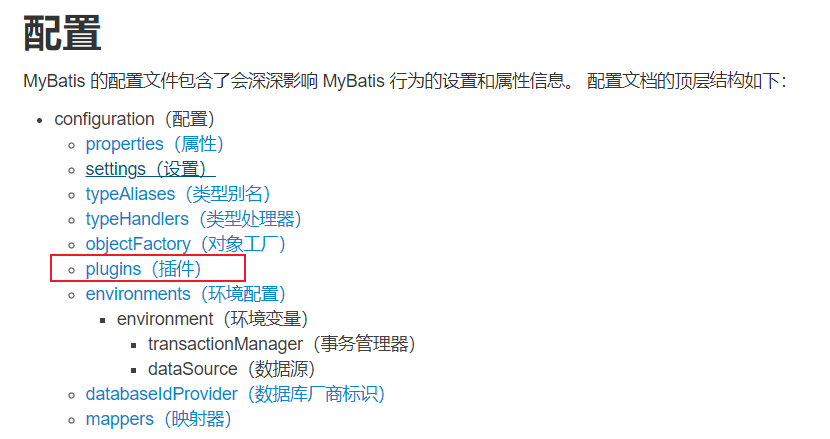
- 问题:什么是Mybatis插件?有什么作用?
一般开源框架都会提供扩展点,让开发者自行扩展,从而完成逻辑的增强。
基于插件机制可以实现了很多有用的功能,比如说分页,字段加密,监控等功能,这种通用的功能,就如同AOP一样,横切在数据操作上
而通过Mybatis插件可以实现对框架的扩展,来实现自定义功能,并且对于用户是无感知的。
# 12.2 Mybatis插件介绍
Mybatis插件本质上来说就是一个拦截器,它体现了JDK动态代理和责任链设计模式的综合运用
Mybatis中针对四大组件提供了扩展机制,这四个组件分别是:
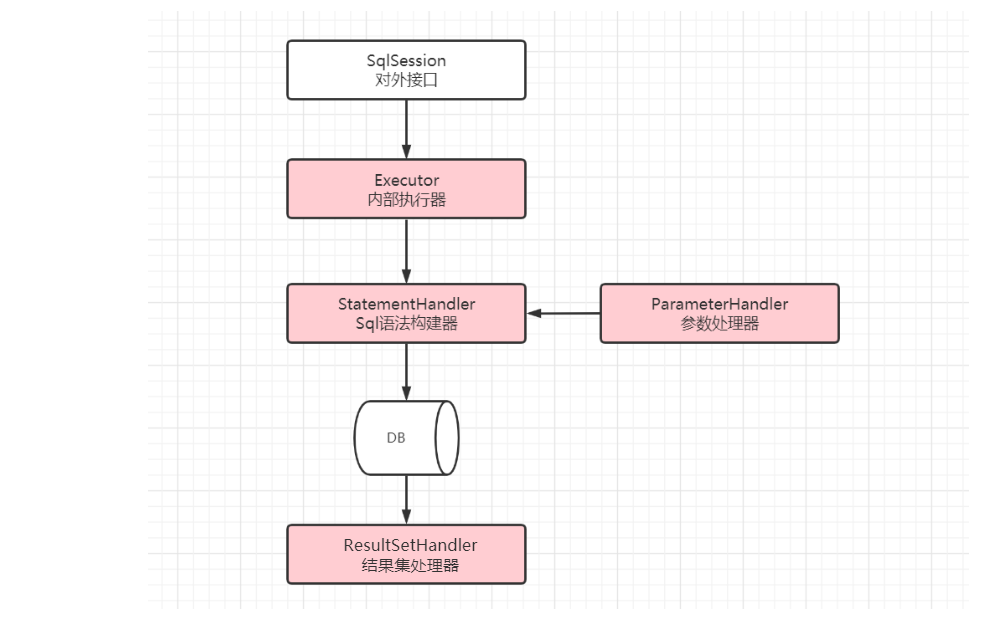
Mybatis中所允许拦截的方法如下:
- Executor 【SQL执行器】【update,query,commit,rollback】
- StatementHandler 【Sql语法构建器对象】【prepare,parameterize,batch,update,query等】
- ParameterHandler 【参数处理器】【getParameterObject,setParameters等】
- ResultSetHandler 【结果集处理器】【handleResultSets,handleOuputParameters等】
# 能干什么?
- 分页功能:mybatis的分页默认是基于内存分页的(查出所有,再截取),数据量大的情况下效率较低,不过使用mybatis插件可以改变该行为,只需要拦截StatementHandler类的prepare方法,改变要执行的SQL语句为分页语句即可
- 性能监控:对于SQL语句执行的性能监控,可以通过拦截Executor类的update, query等方法,用日志记录每个方法执行的时间
# 如何自定义插件?
在使用之前,我们先来看看Mybatis提供的插件相关的类,过一遍它们分别提供了哪些功能,最后我们自己定义一个插件
用于定义插件的类
前面已经知道Mybatis插件是可以对Mybatis中四大组件对象的方法进行拦截,那拦截器拦截哪个类的哪个方法如何知道,就由下面这个注解提供拦截信息
@Documented
@Retention(RetentionPolicy.RUNTIME)
@Target(ElementType.TYPE)
public @interface Intercepts {
Signature[] value();
}
2
3
4
5
6
由于一个拦截器可以同时拦截多个对象的多个方法,所以就使用了Signture数组,该注解定义了拦截的完整信息
@Documented
@Retention(RetentionPolicy.RUNTIME)
@Target({})
public @interface Signature {
// 拦截的类
Class<?> type();
// 拦截的方法
String method();
// 拦截方法的参数
Class<?>[] args();
}
2
3
4
5
6
7
8
9
10
11
12
已经知道了该拦截哪些对象的哪些方法,拦截后要干什么就需要实现Intercetor#intercept方法,在这个方法里面实现拦截后的处理逻辑
public interface Interceptor {
/**
* 真正方法被拦截执行的逻辑
*
* @param invocation 主要目的是将多个参数进行封装
*/
Object intercept(Invocation invocation) throws Throwable;
// 生成目标对象的代理对象
default Object plugin(Object target) {
return Plugin.wrap(target, this);
}
// 可以拦截器设置一些属性
default void setProperties(Properties properties) {
// NOP
}
}
2
3
4
5
6
7
8
9
10
11
12
13
14
15
16
17
18
19
# 12.3 自定义插件
需求:把Mybatis所有执行的sql都记录下来
步骤:① 创建Interceptor的实现类,重写方法
② 使用@Intercepts注解完成插件签名 说明插件的拦截四大对象之一的哪一个对象的哪一个方法
③ 将写好的插件注册到全局配置文件中
①.创建Interceptor的实现类
public class MyPlugin implements Interceptor {
private final Logger logger = LoggerFactory.getLogger(this.getClass());
// //这里是每次执行操作的时候,都会进行这个拦截器的方法内
Override
public Object intercept(Invocation invocation) throws Throwable {
//增强逻辑
StatementHandler statementHandler = (StatementHandler) invocation.getTarget();
BoundSql boundSql = statementHandler.getBoundSql();
String sql = boundSql.getSql();
logger.info("mybatis intercept sql:{}", sql);
return invocation.proceed(); //执行原方法
}
/**
*
* ^Description包装目标对象 为目标对象创建代理对象
* @Param target为要拦截的对象
* @Return代理对象
*/
Override
public Object plugin(Object target) {
System.out.println("将要包装的目标对象:"+target);
return Plugin.wrap(target,this);
}
/**获取配置文件的属性**/
//插件初始化的时候调用,也只调用一次,插件配置的属性从这里设置进来
Override
public void setProperties(Properties properties) {
System.out.println("插件配置的初始化参数:"+properties );
}
}
2
3
4
5
6
7
8
9
10
11
12
13
14
15
16
17
18
19
20
21
22
23
24
25
26
27
28
29
30
31
32
33
② 使用@Intercepts注解完成插件签名 说明插件的拦截四大对象之一的哪一个对象的哪一个方法
@Intercepts({ @Signature(type = StatementHandler.class,
method = "prepare",
args = { Connection.class, Integer.class}) })
public class SQLStatsInterceptor implements Interceptor {
2
3
4
③ 将写好的插件注册到全局配置文件中
<?xml version="1.0" encoding="UTF-8" ?>
<!DOCTYPE configuration PUBLIC "-//mybatis.org//DTD Config 3.0//EN"
"http://mybatis.org/dtd/mybatis-3-config.dtd">
<configuration>
<plugins>
<plugin interceptor="com.itheima.interceptor.MyPlugin">
<property name="dialect" value="mysql" />
</plugin>
</plugins>
</configuration>
2
3
4
5
6
7
8
9
10
# 核心思想:
就是使用JDK动态代理的方式,对这四个对象进行包装增强。具体的做法是,创建一个类实现Mybatis的拦截器接口,并且加入到拦截器链中,在创建核心对象的时候,不直接返回,而是遍历拦截器链,把每一个拦截器都作用于核心对象中。这么一来,Mybatis创建的核心对象其实都是代理对象,都是被包装过的。
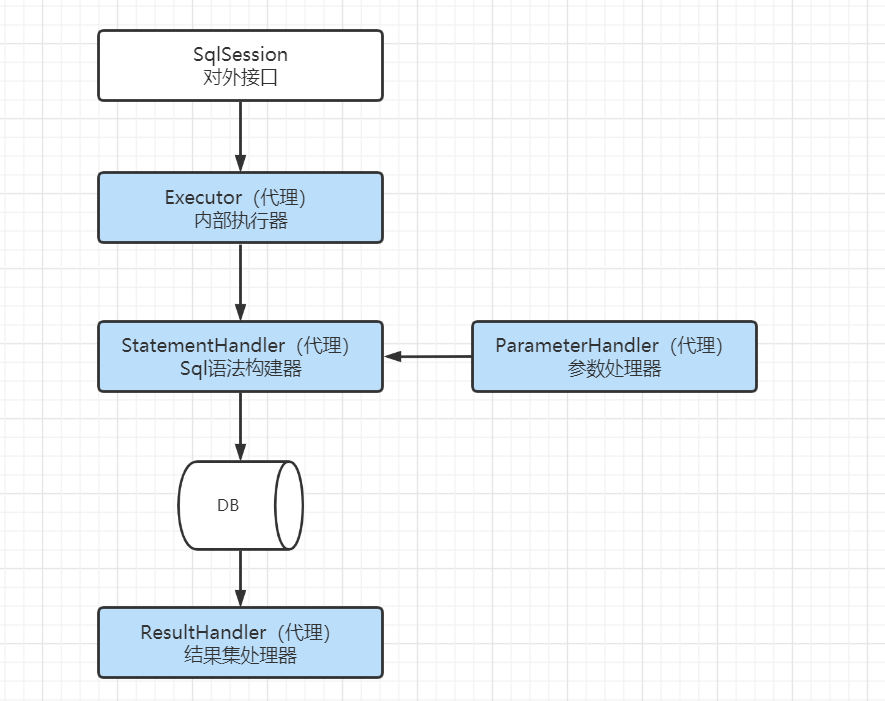
# 12.4 源码分析-插件
- 插件的初始化:插件对象是如何实例化的? 插件的实例对象如何添加到拦截器链中的? 组件对象的代理对象是如何产生的?
- 拦截逻辑的执行
# 插件配置信息的加载
我们定义好了一个拦截器,那我们怎么告诉Mybatis呢?Mybatis所有的配置都定义在XXx.xml配置文件中
<?xml version="1.0" encoding="UTF-8" ?>
<!DOCTYPE configuration PUBLIC "-//mybatis.org//DTD Config 3.0//EN"
"http://mybatis.org/dtd/mybatis-3-config.dtd">
<configuration>
<plugins>
<plugin interceptor="com.itheima.interceptor.MyPlugin">
<property name="dialect" value="mysql" />
</plugin>
</plugins>
</configuration>
2
3
4
5
6
7
8
9
10
对应的解析代码如下(XMLConfigBuilder#pluginElement):
private void pluginElement(XNode parent) throws Exception {
if (parent != null) {
for (XNode child : parent.getChildren()) {
// 获取拦截器
String interceptor = child.getStringAttribute("interceptor");
// 获取配置的Properties属性
Properties properties = child.getChildrenAsProperties();
// 根据配置文件中配置的插件类的全限定名 进行反射初始化
Interceptor interceptorInstance = (Interceptor) resolveClass(interceptor).getDeclaredConstructor().newInstance();
// 将属性添加到Intercepetor对象
interceptorInstance.setProperties(properties);
// 添加到配置类的InterceptorChain属性,InterceptorChain类维护了一个List<Interceptor>
configuration.addInterceptor(interceptorInstance);
}
}
}
2
3
4
5
6
7
8
9
10
11
12
13
14
15
16
主要做了以下工作:
- 遍历解析plugins标签下每个plugin标签
- 根据解析的类信息创建Interceptor对象
- 调用setProperties方法设置属性
- 将拦截器添加到Configuration类的IntercrptorChain拦截器链中
对应时序图如下:
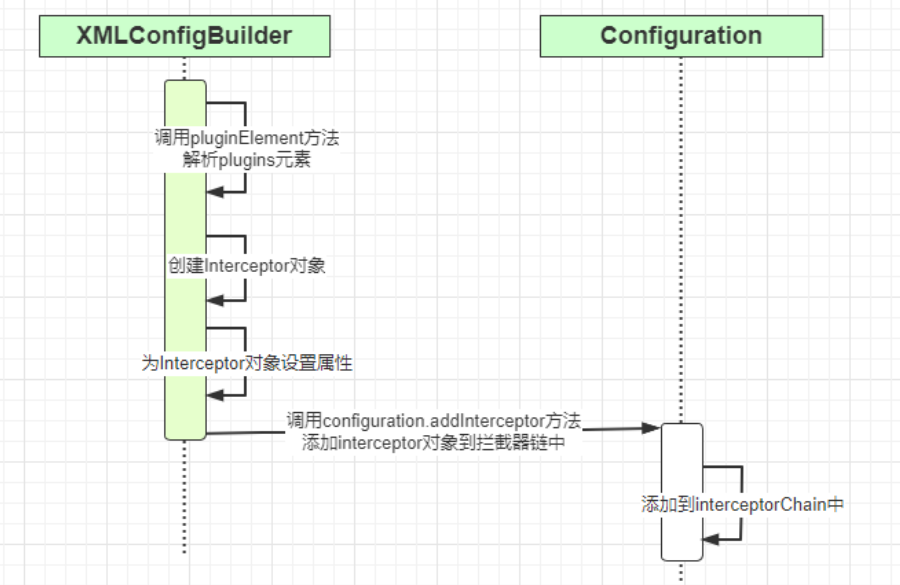
# 代理对象的生成
Executor代理对象(Configuration#newExecutor)
public Executor newExecutor(Transaction transaction, ExecutorType executorType) {
executorType = executorType == null ? defaultExecutorType : executorType;
executorType = executorType == null ? ExecutorType.SIMPLE : executorType;
Executor executor;
if (ExecutorType.BATCH == executorType) {
executor = new BatchExecutor(this, transaction);
} else if (ExecutorType.REUSE == executorType) {
executor = new ReuseExecutor(this, transaction);
} else {
executor = new SimpleExecutor(this, transaction);
}
if (cacheEnabled) {
executor = new CachingExecutor(executor);
}
// 生成Executor代理对象逻辑
executor = (Executor) interceptorChain.pluginAll(executor);
return executor;
}
2
3
4
5
6
7
8
9
10
11
12
13
14
15
16
17
18
19
20
ParameterHandler代理对象(Configuration#newParameterHandler)
public ParameterHandler newParameterHandler(MappedStatement mappedStatement, Object parameterObject, BoundSql boundSql) {
ParameterHandler parameterHandler = mappedStatement.getLang().createParameterHandler(mappedStatement, parameterObject, boundSql);
// 生成ParameterHandler代理对象逻辑
parameterHandler = (ParameterHandler) interceptorChain.pluginAll(parameterHandler);
return parameterHandler;
}
2
3
4
5
6
ResultSetHandler代理对象(Configuration#newResultSetHandler)
public ResultSetHandler newResultSetHandler(Executor executor, MappedStatement mappedStatement, RowBounds rowBounds, ParameterHandler parameterHandler,
ResultHandler resultHandler, BoundSql boundSql) {
ResultSetHandler resultSetHandler = new DefaultResultSetHandler(executor, mappedStatement, parameterHandler, resultHandler, boundSql, rowBounds);
// 生成ResultSetHandler代理对象逻辑
resultSetHandler = (ResultSetHandler) interceptorChain.pluginAll(resultSetHandler);
return resultSetHandler;
}
2
3
4
5
6
7
8
9
StatementHandler代理对象(Configuration#newStatementHandler)
public StatementHandler newStatementHandler(Executor executor, MappedStatement mappedStatement, Object parameterObject, RowBounds rowBounds, ResultHandler resultHandler, BoundSql boundSql) {
StatementHandler statementHandler = new RoutingStatementHandler(executor, mappedStatement, parameterObject, rowBounds, resultHandler, boundSql);
// 生成StatementHandler代理对象逻辑
statementHandler = (StatementHandler) interceptorChain.pluginAll(statementHandler);
return statementHandler;
}
2
3
4
5
6
7
8
通过查看源码会发现,所有代理对象的生成都是通过InterceptorChain#pluginAll方法来创建的,进一步查看pluginAll方法
public Object pluginAll(Object target) {
for (Interceptor interceptor : interceptors) {
target = interceptor.plugin(target);
}
return target;
}
2
3
4
5
6
7
8
9
10
InterceptorChain#pluginAll内部通过遍历Interceptor#plugin方法来创建代理对象,并将生成的代理对象又赋值给target,如果存在多个拦截器的话,生成的代理对象会被另一个代理对象所代理,从而形成一个代理链,执行的时候,依次执行所有拦截器的拦截逻辑代码,我们再跟进去
default Object plugin(Object target) {
return Plugin.wrap(target, this);
}
2
3
4
5
Interceptor#plugin方法最终将目标对象和当前的拦截器交给Plugin.wrap方法来创建代理对象。该方法是默认方法,是Mybatis框架提供的一个典型plugin方法的实现。让我们看看在Plugin#wrap方法中是如何实现代理对象的
public static Object wrap(Object target, Interceptor interceptor) {
// 1.解析该拦截器所拦截的所有接口及对应拦截接口的方法
Map<Class<?>, Set<Method>> signatureMap = getSignatureMap(interceptor);
Class<?> type = target.getClass();
// 2.获取目标对象实现的所有被拦截的接口
Class<?>[] interfaces = getAllInterfaces(type, signatureMap);
// 3.目标对象有实现被拦截的接口,生成代理对象并返回
if (interfaces.length > 0) {
// 通过JDK动态代理的方式实现
return Proxy.newProxyInstance(
type.getClassLoader(),
interfaces,
new Plugin(target, interceptor, signatureMap));
}
// 目标对象没有实现被拦截的接口,直接返回原对象
return target;
}
2
3
4
5
6
7
8
9
10
11
12
13
14
15
16
17
18
19
最终我们看到其实是通过JDK提供的Proxy.newProxyInstance方法来生成代理对象
以上代理对象生成过程的时序图如下:
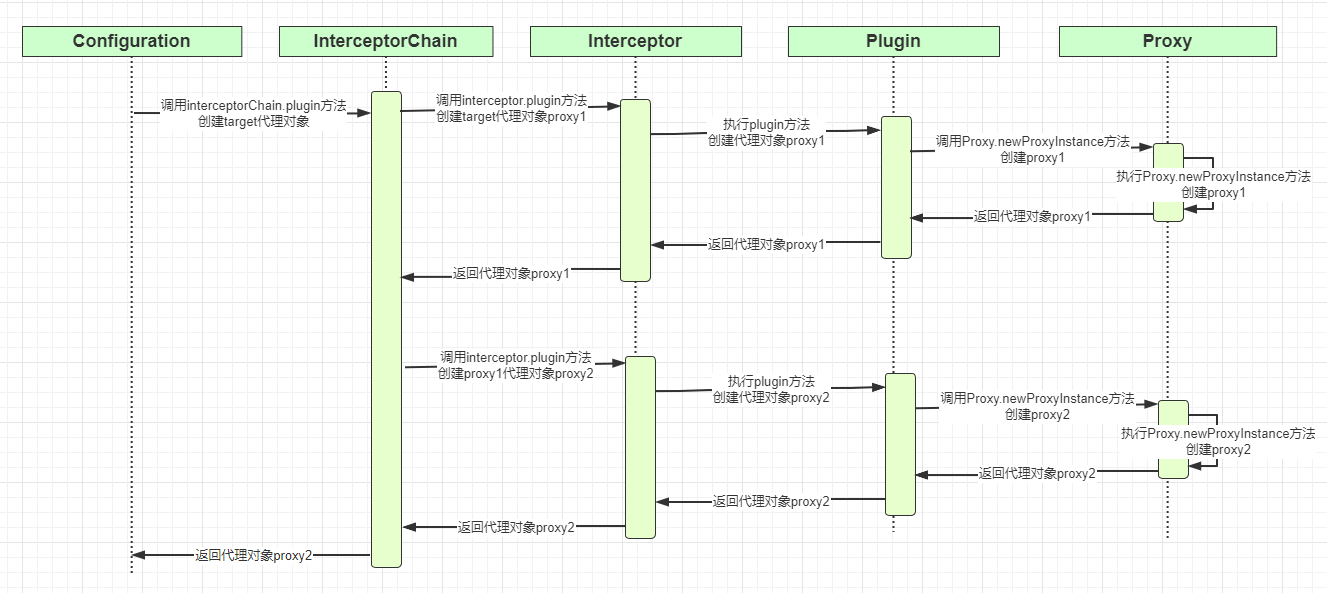
# 拦截逻辑的执行
通过上面的分析,我们知道Mybatis框架中执行Executor、ParameterHandler、ResultSetHandler和StatementHandler中的方法时真正执行的是代理对象对应的方法。而且该代理对象是通过JDK动态代理生成的,所以执行方法时实际上是调用InvocationHandler#invoke方法(Plugin类实现InvocationHandler接口),下面是Plugin#invoke方法
@Override
public Object invoke(Object proxy, Method method, Object[] args) throws Throwable {
try {
Set<Method> methods = signatureMap.get(method.getDeclaringClass());
if (methods != null && methods.contains(method)) {
return interceptor.intercept(new Invocation(target, method, args));
}
return method.invoke(target, args);
} catch (Exception e) {
throw ExceptionUtil.unwrapThrowable(e);
}
}
2
3
4
5
6
7
8
9
10
11
12
注:一个对象被代理很多次
问题:同一个组件对象的同一个方法是否可以被多个拦截器进行拦截?
答案是肯定的,所以我们配置在最前面的拦截器最先被代理,但是执行的时候却是最外层的先执行。
具体点:
假如依次定义了三个插件:插件1,插件2 和 插件3。
那么List中就会按顺序存储:插件1,插件2 和 插件3。
而解析的时候是遍历list,所以解析的时候也是按照:插件1,插件2,插件3的顺序。
但是执行的时候就要反过来了,执行的时候是按照:插件3,插件2和插件1的顺序进行执行。
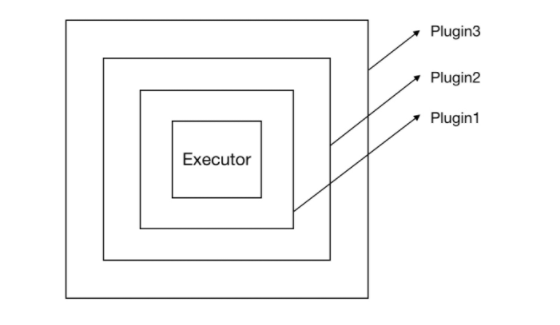
当 Executor 的某个方法被调用的时候,插件逻辑会先行执行。执行顺序由外而内,比如上图的执行顺序为 plugin3 → plugin2 → Plugin1 → Executor。

